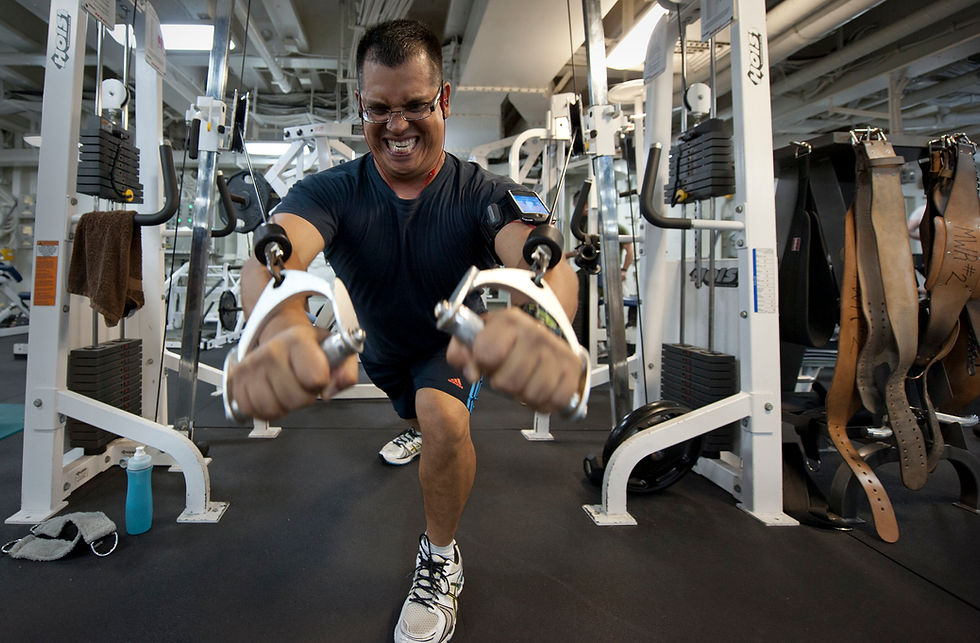Does Soreness Equal a Good Workout?
- TM Nutrition Training
- Oct 26, 2017
- 4 min read
No. Too bold? I don’t think so.
I don’t want to come across wishy washy and leave room for the stimulus addicts to keep pounding away trying to get sore. I will concede there are actually plenty of times you may be sore after a good workout. However, there are also plenty of ways you could end up sore without any sign that what you did in the gym was helping you achieve your goals.

And that IS the point right? You have goals and a workout out should be specific activities designed to move you closer to attaining your goals, not arbitrary exercises thrown together to make you sore or tired. You must ask yourself, why am I doing this? If you cannot not justify doing an exercise other than to make you sore or tired, then it probably does not belong in your routine.
Let’s back up a bit, why do you get sore? There are several things and this is not an exhaustive list. Soreness will often result from novel stimuli. Therefore, the new routine you started will likely leave you sore, in fact, you may be very sore. Your body is not used to the demands you are placing on it and it will let you know! However, the human body is also amazingly adaptive and several weeks into a new routine you may find those same exercises that made you barely able to walk on day 1 are now not leaving you sore at all. Did the exercises suddenly become ineffective? No, your body is adapting and getting stronger.
Even when you’ve been training consistently, you can still introduce novel stimuli that will leave you sore. Several examples would be a sudden increase in volume, more stretch position exercises and more time in the eccentric portion of the movement.
Taking those one at a time, an increase in volume means if you were used to doing 3 sets of 10 repetitions for the squat and you suddenly decide to do 6 sets of 10, this doubling of volume will likely leave you sore. Stretch position exercises refer to those exercises that put your muscles into a deep stretch; examples include but are not limited to back extensions (hamstrings), chest fly, overhead tricep extensions, and sissy squats. The eccentric portion of the repetition is the lowering phase where gravity takes over and the muscle is being slightly stretched, the concentric portion is where the muscle you are targeting is actively pushing or pulling the weight.
What do novel stimuli, increased volume, stretch position exercises and increased eccentrics all have in common? Increased micro trauma to the muscle which is what leaves you sore the next day or the day after, often referred to as Delayed Onset Muscle Soreness or DOMS. A common misconception is that lactic acid makes you sore. Lactic acid is what causes the burn you feel in your muscle on a high repetition set. However, lactic acid clears your body relatively quickly after a workout and it is not what makes you sore.
So if micro trauma leaves you sore, what can you do to stop it? Not too much honestly. Good recovery in terms of proper nutrition and sleep will help. But honestly, it should not be much of an issue. You should be finding that balance in your training. If you are insanely sore all of the time, you are likely not recovering from your workout either because you are doing too much in the gym or you are not eating/sleeping well enough or a combination of the two. If that is the case, you need to reevaluate your routine and not keep plugging away.
Can I workout if I am sore? Sure, if you are a little sore, doing a light workout to stimulate blood flow will be beneficial.
How do I know if it is soreness or injury? Several things come to mind. First, is the pain bilateral or unilateral? If you performed a shoulder routine and only one shoulder is sore, it may be the sign of a slight injury. But if they both feel equally sore, it may be just some normal micro trauma. If the soreness you feel seems to be more in the joint versus in the muscle, then it may be an injury. Also, it the pain is chronic rather than temporarily, it may be an injury.
What if you are not convinced after reading what I wrote? You want to do novel stimuli frequently and you want to do increase your volume and perform slow eccentrics. What do I say to you?
I say analyze your goals and see if your training matches up with your goals. If your goal is to get stronger but you are doing tons of high repetitions because you like to get sore, you are not matching your training to your goals. If your goal is to build muscle, then some of the methods of creating soreness will be beneficial to you, but you may not be matching up your nutrition with your goal. If you are too sore after your muscle building workouts then you are not going to recover and build muscle. If your goal is to lose body fat, you will be in a caloric deficit and already not recovering well, you likely do not want to create additional soreness. Further, big compound movements will be your friend during a fat loss phase and often those movements are hard to do with exaggerated eccentrics or the deep stretches that cause soreness.
Training to feel sore tomorrow is short sighted. Step back and look at the big picture. Train with your future goals in mind.















Comments